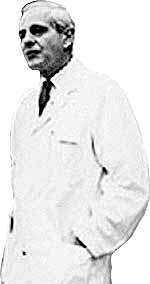

| ||
| Some of Lehmann’s contemporaneous experiments at Verdun (now Douglas) hospital (above) were fatal, yet have gone virtually without comment. |

ot so lucky were Lehmann’s subjects. After being given large amounts of chlorpromazine, several died of “fecal impaction” as the drug destroyed their body’s ability to have normal bowel movements. The Gazette article made no mention of the deaths.
As reported in the Canadian Medical Association Journal, one patient, a 51-year-old woman, “vomited feces, went into shock and died. Autopsy revealed acute colitis and peritonitis, secondary to a large tumor-like fecal mass in the rectum.”
Two others recorded in the article suffered abdominal cramps, went into shock and died. Five other patients developed severe obstruction of the intestines and acute bowel pain.
Bob Dobson-Smith, president of the Citizens Commission on Human Rights Canada, toured more than 70 major psychiatric facilities in Canada in 1972 and 1973 in an early phase of his organization’s long-standing campaign to expose and eradicate abuses in the field of mental health. During those tours, he met thousands of patients suffering from severe illnesses, including tardive dyskinesia, after being on chlorpromazine.
He recalls listening to a show during that time on Canadian Broadcasting Corporation radio on which Lehmann and a psychiatric survivor were guests.
“This patient said that she had been on chlorpromazine and was now unable to walk,” said Dobson-Smith. “Instead of suggesting she decrease the dosage, Lehmann recommended it be doubled to produce a ‘therapeutic dosage.’”
Similarly, documents show that when one of Lehmann’s patients failed to respond during one experiment with the drug, funded by the then U.S. Department of Health, Education and Welfare, Lehmann increased the dose several times above the recommended level. Other patients began to develop jaundice and symptoms of Parkinson’s disease during the course of his experiments.
Helpless Obedience

eter Breggin, psychiatrist, author and founder of the Center for the Study of Psychiatry and Psychology in Bethesda, Maryland, compared Lehmann’s experiments to those conducted by Nazi-era psychiatrists in Germany. He said chlorpromazine was never intended to treat mental illness, but rather to disable patients so they would not “cause trouble.”
“In many ways, these drugs can accomplish in a few doses what took years for the Nazis to do to put people in a state of helpless obedience,” said Breggin. “Within one year, most patients in most mental hospitals were on these drugs because they were so effective at suppressing rebellion.”
Just so much can be blamed on the archaic methods and bad conditions prevailing in the field of mental health at the time Heinz Lehmann undertook his experiments.
He conducted most of his work after passage of the Nuremberg Code in 1947, the most important document in the history of the ethics of medical research and the first of its kind to ensure the rights of research subjects. Its provisions include full consent—also meaning patients should have legal capacity to give consent—and prohibition or termination of experiments where reason exists to believe that death or disabling injury will occur.
The adverse effects of chlorpromazine were documented in psychiatric literature well before Lehmann began killing patients with the drug, said Breggin. These included a study published in July 1952 by French researchers Jean Delay and Pierre Deniker as well as studies by Rhone-Poulenc, the drug’s manufacturer.
Andrew Scull, a professor at the University of California at San Diego who has studied Lehmann’s work, said Lehmann’s studies violated every basic tenet of medical ethics, even for that period.
“This was being done right at the same time as the Nuremberg Trials,” he said of Lehmann’s early chlorpromazine experiments. “It’s hard to accept the protestations of ‘We didn’t know any better.’ The point is, they did.”
Scull said the “science” behind the experiments wasn’t science at all.
“The methodology he used was they gave a bunch of patients the drug and said, ‘We looked at them before and after and they were clearly better after the drug.’”
When an aggressive patient, post-lobotomy, sits in an apathetic heap, “does that constitute improvement?” asks Scull.
Immortalized by Pharmaceutical Money

ehmann became a psychiatric icon after his 1953 chlorpromazine “breakthrough.” Claims that the drug “improved” treatment gave psychiatry legitimacy, said Scull, and it opened the door to a multibillion-dollar partnership between psychiatry and the pharmaceutical industry.
The National Institute of Mental Health in Washington, D.C., offered to support Lehmann’s research and gave him a seat on its selection committee to award grants. As an indication of his stature, in 1963, while the U.S. was cutting back on research grants awarded outside the country, Lehmann received one for $100,000—a considerable sum of money by today’s standards, let alone at the time. Lehmann also became one of the longest-serving members on the U.S. government’s Advisory Committee on Psychopharmacology, which investigates and reports on all developments in drugs for use in mental health.
Money seemed to flow endlessly to Lehmann, despite the nature of his experiments.
Silent Partners

n the two and a half decades since exposure of the infamous psychiatric “mind-control” experiments of the 1950s and 1960s, only Lehmann’s colleague Ewen Cameron would bear close scrutiny, due to his prominent role in the MK ULTRA program.
Colin Ross, M.D., a nationally consulted expert on psychological trauma, said in a radio interview that a deliberate campaign of disinformation was carried out by the psychiatric community to limit the scope of damage to psychiatry’s reputation.

| ||
| Heinz Lehmann has been acclaimed by the psychiatric community for introducing drugs into treatment. Yet the substances he used resulted in damage and death to patients. Lehmann himself called the drug that he used most, Largactil (Thorazine), a “pharmacological substitute for lobotomy.” |
“Well, that’s not true because that research completely violated the ethical standards of the time, but also it wasn’t an isolated incident.”
Cameron’s MK ULTRA money ultimately came from the U.S. Department of Health, Education and Welfare and the U.S. Department of Defense; the funds were secretly channeled by the CIA through a front group known as the Human Ecology Fund.
Lehmann’s work was financed largely by hundreds of thousands of dollars in overt grants from the same U.S. government departments. He also received money from Canada’s Defense Research Board.
Virtually every patient treated by Cameron under MK ULTRA was administered chlorpromazine, as revealed in declassified CIA records.
Washington, D.C., lawyer James Turner, who represented the Canadian victims of Cameron’s experiments in their successful civil lawsuit against the CIA, finds it significant that chlorpromazine was not on the CIA’s list of drugs it was testing at that time. He said the omission raises the distinct possibility that Cameron had a silent partner in Lehmann.
Lehmann wrote that after Cameron established the Department of Psychiatry at McGill University in the late 1940s, he “gave me opportunities to do undergraduate and postgraduate teaching.” The two psychiatrists remained associates until Cameron’s death.
Lehmann continued his affiliation with McGill for decades, moving up to clinical director and associate professor of psychiatry in 1958, and becoming chairman of the psychiatry department in 1971. In his twilight years, he took the position of assistant professor in 1979, and professor emeritus in 1981, as well as positions in New York State’s mental health agencies. Lehmann died in April 1999, immortalized in American and Canadian medical history.
Certainly enough evidence exists concerning Lehmann’s ties to Ewen Cameron and his inhumane actions toward patients to raise serious questions, said psychiatric survivor and activist, Don Weitz.
Weitz, founder of People Against Coercive Treatment (PACT), said Lehmann was no healer or human rights advocate.
“Lehmann was a drug pusher, shock promoter and torturer—just as psychiatrist Ewen Cameron was. We now know that Lehmann forcibly drugged hundreds of psychiatric patients with high-risk, experimental drugs such as chlorpromazine which he knew or ought to have known would cause serious harm including brain damage.”
Learning the Truth

oday, Bob Dobson-Smith said, whether or not the work of Lehmann and others was conducted for secret intelligence purposes is not the critical point. “Why they did it makes no difference in the lives of the patients who suffered. The most important thing now is that remaining survivors and their families learn the truth and are recompensed.
“The psychiatrists and others knew what was going on. Any ‘lone gunman’ theory doesn’t hold up,” he said. “To this day, psychiatrists condone and excuse the activities of these prominent forefathers and members, and for the most part they have carried on in the same vein, always claiming their treatment is ‘better’ now, more ‘modern.’ And always reporting that more and more people are mentally ill.”
In a media interview in his late life in which he discussed his years of experiments, Lehmann was to say, “I didn’t ask the patients, I didn’t ask the relatives ... I certainly didn’t have to ask the government which I would have to do now.... I did what I thought was right.”
The facts, however, reveal that in doing “what they thought was right,” Lehmann, Cameron, and other pillars of the psychiatric community left a legacy of drugged and shattered lives.

